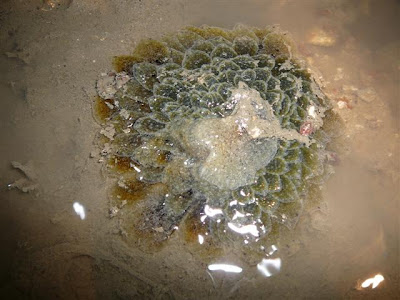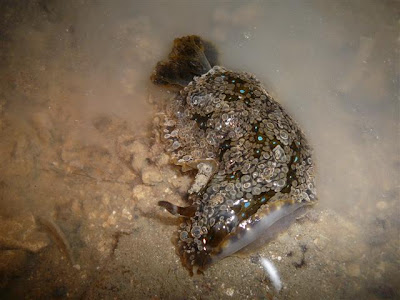On a Saturday afternoon, we had the privilege to attend a sea anemone workshop conducted by world expert, Dr Daphne Fautin.
Dr Daphne shared with us many interested facts about anemones, many of which we didn't know. Sea anemones are anatomically simple animals with one body opening and no organs. But they are functionally complex including the ability to reproduce sexually.
She also revealed to us what are NOT true anemones like the "mushroom anemones" of order Corallimorpharia, zoathids and the most commonly mistake "peacock anemones" of order Cerianthiaria.
I'm also came to know that actually all anemones are carnivores and many true anemones burrow. Not only that, we also were enlightened on how these anemones move, interact and adapt to other species and the environment.
Dr Daphne also shared on the symbiotic relationship of anemonefishes with the anemones. It is obvious that these anemones protect the hosting fishes against predators but does sea anemones benefit by hosting fishes?
The answer is not necessarily; not all. However, there are cases where shortly after fish collectors took away the anemonefishes, and within 10 minutes, butterflyfishes move in to feed on these vacant "defensiveless" anemones! Therefore, anemonefishes maybe important after all.
For aquarium lovers, there is simply no reason for you to put an anemone inside the tank to protect anemone fishes because there are no predators in the first place. So please do not poach these 100-300 year old anemones from the wild. Leave them, respect them, they are older than you and I. They live well in the wild.
The workshop was really good and Dr Daphne taught us how to identify sea anemones. We must take note of the external morphology (eg: number of tentacles, arrangement, shape etc), mesenteries, column specialisation, nature of base, presence of acontia (threads emitted) etc. One thing to note is colour is typically NOT diagnostic, a good example will be Heteractis magnifica that comes in different colours.
Towards the end of the slides, Dr Daphne shared on how to collect and preserve anemones for scientific purposes.
And the interesting part is Dr Dahpne solved some of the mysteries of Singapore's very own anemones! The "Peachia" (not) means it is not a peachia as firstly thought to be. Thanks Dr Daphne for all the corrections.
And minimally, Singapore has 32 species of anemones! Wow.
The slides presentation by Dr Dahpne was done and it was time for some specimen or practical time. Here we have a "strawberry" anemone, still alive, waiting for further identification.
These anemones are still alive and doing ok in a tank. Wonder how long can they stay alive?
These little things are also anemones, of which we can find Diadumene luciae.
This is how Stichodactyla tapetum looks like after being preserved.
And they are being preserved in a jar for Raffles Museum.
We saw the live one of this swimming anemone swimming as well. But I don't have the photo though. Airani has it!
We had a good time looking at the anemones with a mircoscope and look at Airani with her camera into the microscope lens. Hey she took VERY nice photos through it. Can't wait to get from her the clips and shots.
As previously mentioned, this is a "false anemone" or the corallimorph. They are very pretty though.
And within the tank, sharp-eyed Chay Hoon spotted something! It is a skeleton shrimp! Can you see it?
That's the best my camera can offer with the microscope lens of the skeleton shrimp. It is extremely small but to everyone's shock, we saw MANY babies attached to the body. wow!
Chay Hoon shared her book on how the skeleton shrimps look like, with hydroids.
I thought they look like "sea monkeys". Hahahahaha.
-------
And here's Airani and Siva's post with great photos and video:
“The Swimming Sea Anemone, Boloceroides mcmurrichi,” by Airani S. & N. Sivasothi.
Habitatnews, 24 Jul 2007
http://habitatnews.nus.edu.sg/index.php?entry=/marine/20070724-mcmurrichi.txt
Monday, July 23, 2007
Sea Anemone Workshop
Tuesday, July 17, 2007
Soft shore of anemones
Early in the morning, we were at Changi with Dr Daphne Fautin, the sea anemone expert. And indeed we learnt so much from her about the anemones we can find on our local shores.
Just seconds after we hit down the shore, Dr Daphne already caught attention on these little guys. They are called Diadumene luciae but it sounds like "die-doom-to-me". Hahaha. They are very common in our shores, even to the high shores zone. They can also be called as Halipanella meaning "world traveller" because they travel to many parts of the world in ballast water. Another name of this anemone is Diadumene lineata.
Don't think these anemones are nobodys! There's a lot more of stories behind them as Ria shares them in wildfilms blog.
This anemone is called Anthopleura handi. Dr Daphne share that this was named after her professor.
Some of these Anthopleura handi anemones can even be found up high on rock crevices.
More anemones were spotted... It looks like a swimming anemone to me.
And wow, didn't know there are anemones living on seagrasses blades. Siti's territory! It's so small that we will not find out ourselves.
This is crudely called the tiger or the strawberry anemone with bumps on the outside. Surprisingly, these "innocent" anemones have long tails in the substrate and they escape real quick when danger arrives.
And they give a good sprinkling job if you really need a wash. Just kidding.
And we finally get the baby carpet anemones debunked. These are not the babies of Stichodactyla haddoni or the carpet anemones we find in Chek Jawa! It is a different species itself and never grows much larger than this. This is actually Stichodactyla tapetum. It has tentacles grouped together into patterns as seen in their neat arrangement.
This is then the baby of the Stichodactyla haddoni. Sorry you cant see it here but the tentacles are evenly spread out. But they can be distinguished with long-short tentacles at the side of these anemone fringes.
Changi has a lot of these sea cucumbers.
Crabs and sandstars...
Squid, hairy seahare, geographical sea hare and a mantis shrimp.
Alvin found a horseshoe crab beside a swimming anemone.
And also this slug underneath a rock. Any idea what is the id??
Update: Chay Hoon suggested its Dendrodoris fumata. Thanks
Last but not the least, Martyn showed us his find of this toadfish.
What a wonderful morning in Changi as we learn so much more about anemones and see other stuffs in the shores.
Saturday, July 14, 2007
Beting Bronok discoveries
Beting Bronok or BB is a reef north of Pulau Tekong that is only exposed at very low tides. And today was my first time visiting this elusive place. The wildfilms and beachfleas gang, together with Dr Chua, were out at 2 plus am already taking a bumboat that cruises through the Straits of Johor, alongside is Chek Jawa and Pulau Tekong.

This slug was first discovered by Marcus and next, November, Walter, Dr Chua and I came over and take a good look. We were baffled and have no idea till Chay Hoon came and told us more about this. I'm so sorry I forgot the name again. Glad Chay Hoon updated that its Polybranchia orientalis. Thanks!

BB is unlike most northern shores. It is more special as in you can find corals. And here's some hard corals enocuntered.

As the bumboat passes by Chek Jawa, managed to take a snapshoot of the front and rear beacon and the boardwalk that hugs this precious shore that Team seagrass will be visiting tomorrow.
Beting Bronok was quite quiet today compared to its former glory. Let's hope it'll recover.
More on how BB was like on the wildfilms blog.
Friday, July 13, 2007
The tranquility of Seletar
Yesterday Gun Kiat and I went to Seletar to take a good look before construction and development starts for a new aerospace centre. Was introduced of this wonderful place by this show that I was glued to watching, called "Hey! Singapore" hosted by Lisa Ang. Many many years ago, I wanted to go in and take a look but at that time, ICs are needed for verification before entering the Seletar complex. I forgot mine so it was a wasted trip back then.
This time managed to go there finally with GK since he has a vehicle, thanks GK!
After a sumptuous lunch at Jalan Kayu roti prata shop, we headed in and you'll be surprised you feel that you are not in Singapore anymore when you are inside. Everywhere looks so countryside and even the road names are so English, for example: The Oval, Oxford street, Park Lane etc.
Resting on top of a signboard is this pacific swallow (Hirundo tahitica). These birds eat insects, catching them during flight.
I managed to catch another shot of two interacting.
After a brief tour of Seletar marvelling at aeroplanes and the nice architectures (please visit my personal blog if you want to see), we headed to the dam or land cutting across Lower seletar reservoir.
At the seaward side, we can see there are mangroves growing on the fringes.
And more mangroves! Wonder how is this place like during low tide.
Looking closer, we saw a couple of grey herons and one special bird that I couldn't id on the spot.
It has distinctive breast bands. After searching through the net, realized its a painted stork (Mycteria leucocephala), a bird that prefers swampy area. It is found easily from India through Southeast Asia, that includes Malaysia and Singapore. But the population in Singapore is most probably escapee from the Bird Park. The favorite food of the Painted Stork is fish, though sometimes they will eat frogs as well. They also eat snails.
Info from http://www.nature2pixel.com/blog/?p=121
Visible from the reservoir is Pulau Seletar, with kelongs nearby at Johor straits.
Before leaving, took at photo of Pulau Punggol Barat where construction is going on to build a bridge across from mainland.























































.jpg)
